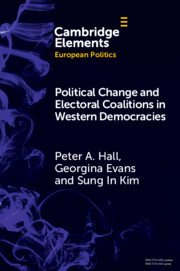Refine search
Actions for selected content:
41 results
Fighting the Cabal from the Diet: Sanseitō and the Role of Conspiracy as Political Ideology
- Part of
-
- Journal:
- Asia-Pacific Journal / Volume 23 / 2025
- Published online by Cambridge University Press:
- 24 September 2025, e14
-
- Article
-
- You have access
- Open access
- HTML
- Export citation
2 - The Fridays for Future Movement and the Repoliticization of Climate Change Policy in Germany
- from Part I - Movement Politics
-
-
- Book:
- Stability and Politicization in Climate Governance
- Published online:
- 07 August 2025
- Print publication:
- 21 August 2025, pp 19-34
-
- Chapter
-
- You have access
- Open access
- HTML
- Export citation
Symbolic Leverage: Nominating (Non)veiled Women as an Electoral Competition Strategy in Polarized Turkey
-
- Journal:
- Politics & Gender , First View
- Published online by Cambridge University Press:
- 16 May 2025, pp. 1-29
-
- Article
-
- You have access
- Open access
- HTML
- Export citation
60 - Constitutional Hardball
- from Part IV - Challenges for Constitutional Democracy
-
-
- Book:
- The Cambridge Handbook of Constitutional Theory
- Published online:
- 27 March 2025
- Print publication:
- 24 April 2025, pp 1070-1088
-
- Chapter
- Export citation
The politics of minimum income reform in Spain: explaining unexpected and consensual path departure
-
- Journal:
- Journal of Social Policy , First View
- Published online by Cambridge University Press:
- 10 April 2025, pp. 1-18
-
- Article
-
- You have access
- Open access
- HTML
- Export citation
Does mainstream populism work? Populist rhetoric and the electoral fortunes of mainstream parties
-
- Journal:
- Political Science Research and Methods , First View
- Published online by Cambridge University Press:
- 24 March 2025, pp. 1-13
-
- Article
-
- You have access
- Open access
- HTML
- Export citation
Pushes and pulls of father leave policy reform: Unpacking divergent father leave reforms in the Czech Republic and South Korea
-
- Journal:
- Journal of International and Comparative Social Policy / Volume 40 / Issue 3 / November 2024
- Published online by Cambridge University Press:
- 10 March 2025, pp. 265-283
-
- Article
-
- You have access
- Open access
- HTML
- Export citation
The political drivers of antipoverty policy in Italy: persistence, change and reversals
-
- Journal:
- Modern Italy , First View
- Published online by Cambridge University Press:
- 22 January 2025, pp. 1-14
-
- Article
-
- You have access
- Open access
- HTML
- Export citation

Cleavage Formation in the 21st Century
- How Social Identities Shape Voting Behavior in Contexts of Electoral Realignment
-
- Published online:
- 09 December 2024
- Print publication:
- 05 December 2024
-
- Element
-
- You have access
- Open access
- HTML
- Export citation
Estimating Ideal Points of British MPs Through Their Social Media Followership
-
- Journal:
- British Journal of Political Science / Volume 54 / Issue 4 / October 2024
- Published online by Cambridge University Press:
- 08 November 2024, pp. 1506-1518
-
- Article
-
- You have access
- Open access
- HTML
- Export citation
11 - Social Democracy and Party Competition
- from Part III - Determinants of Electoral Outcomes for Social Democratic Parties and the Left
-
-
- Book:
- Beyond Social Democracy
- Published online:
- 31 August 2024
- Print publication:
- 27 June 2024, pp 314-341
-
- Chapter
-
- You have access
- Open access
- HTML
- Export citation
9 - Conclusion
-
- Book:
- Why the Electoral College Is Bad for America
- Published online:
- 09 November 2023
- Print publication:
- 23 November 2023, pp 194-208
-
- Chapter
- Export citation
Nostalgia in European Party Politics: A Text-Based Measurement Approach
-
- Journal:
- British Journal of Political Science / Volume 54 / Issue 3 / July 2024
- Published online by Cambridge University Press:
- 13 November 2023, pp. 993-1005
-
- Article
-
- You have access
- Open access
- HTML
- Export citation

Political Change and Electoral Coalitions in Western Democracies
-
- Published online:
- 14 July 2023
- Print publication:
- 10 August 2023
-
- Element
- Export citation
Who benefits from the social democratic march to the middle?
-
- Journal:
- European Political Science Review / Volume 15 / Issue 4 / November 2023
- Published online by Cambridge University Press:
- 14 April 2023, pp. 502-522
-
- Article
-
- You have access
- Open access
- HTML
- Export citation
How challenger party issue entrepreneurship and mainstream party strategies drive public issue salience: evidence from radical-right parties and the issue of immigration
-
- Journal:
- European Political Science Review / Volume 14 / Issue 4 / November 2022
- Published online by Cambridge University Press:
- 27 July 2022, pp. 544-565
-
- Article
-
- You have access
- Open access
- HTML
- Export citation
Old party, new tricks: candidates, parties, and LDP dominance in Japan
-
- Journal:
- Japanese Journal of Political Science / Volume 23 / Issue 3 / September 2022
- Published online by Cambridge University Press:
- 24 June 2022, pp. 283-293
-
- Article
- Export citation
Income inequality in authoritarian regimes: the role of political institutions and state capacity
-
- Journal:
- Italian Political Science Review / Rivista Italiana di Scienza Politica / Volume 53 / Issue 2 / July 2023
- Published online by Cambridge University Press:
- 24 June 2022, pp. 161-178
- Print publication:
- July 2023
-
- Article
-
- You have access
- Open access
- HTML
- Export citation
How Much of Electoral Politics Is in the District? Measuring District Effects on Party Support
-
- Journal:
- Canadian Journal of Political Science/Revue canadienne de science politique / Volume 55 / Issue 1 / March 2022
- Published online by Cambridge University Press:
- 17 December 2021, pp. 150-170
-
- Article
- Export citation
How the refugee crisis and radical right parties shape party competition on immigration
-
- Journal:
- Political Science Research and Methods / Volume 10 / Issue 3 / July 2022
- Published online by Cambridge University Press:
- 15 November 2021, pp. 524-544
-
- Article
-
- You have access
- Open access
- HTML
- Export citation
